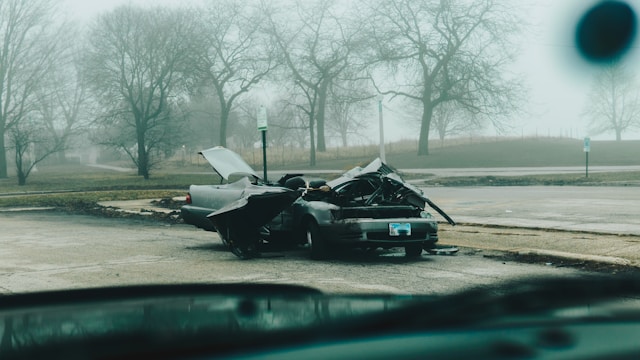
A car accident can be stressful. This Canadian guide gets you back on track fast. Learn key steps to take after a collision, from ensuring your safety to protecting your rights. Take a deep breath, we’ve got this.
1.Ensure Safety and Check for Injuries
After a vehicle collision, the first few seconds might pass quickly. It is important to remain composed and take the appropriate action. The safety of everyone is your first concern. Inspect both you and your passengers for wounds. Make an instant 911 call if someone is wounded. It’s important to act quickly if symptoms appear since small injuries might deteriorate over time.
Try to get your car to a secure spot off the road as soon as you’ve made sure everyone is alright. This might be in a parking lot, on the shoulder, or any other area free of cars. Before you proceed, turn on your warning lights to alert other cars. If the damage to your automobile is too great to move, wait for assistance in a conspicuous and safe location on the side of the road.
2. Call the Police and File a Report
Contact the police, regardless of the severity of the accident. A police report serves as an official record of the accident, documenting details like location, time, weather conditions, and parties involved. It can be invaluable evidence for insurance claims and potential legal disputes.
3. Exchange Information with the Other Driver
When it’s safe to do so, give the other drivers in the collision your details. This includes:
- Complete names and contact information (addresses and phone numbers)
- License plates and driver’s licenses
- Details about the insurance company (name, policy number)
- Do not admit fault or discuss the accident details in-depth. Simply exchange information and stick to the facts.
4. Document the Scene
After you’ve secured your car and everyone is okay, it’s critical to take pictures of the accident area. Make sure you have the person’s consent before taking any photos if there are any injuries.
When shooting pictures, make sure to get a range of details:
- Visible injuries: Once more, only obtain consent before taking any photos of injuries.
- Debris and Skid Marks: These may include important evidence.
- Lights and Traffic Signals: These contribute to the scene’s arrangement.
- Damage to Every Vehicle Involved: Obtain both broad and close-up photos.
- Weather and Potential Dangers on the Roads: This information could be useful.
5. Contact Your Insurance Company
Take action right now! Notify your insurance provider of the accident as soon as you can. They’ll help you navigate their claims procedure and offer you guidance on what to do next.
6. Seek Legal Advice (Optional but Recommended)
While it’s not usually required for small infractions, speaking with a car accident lawyer with expertise may be quite helpful. They may help you with vehicle accident claims in Canada, negotiate proper compensation, and even defend you in court if you have serious injuries, are the victim of a hit-and-run accident, or have a dispute with the insurance company.
Finding a Car Accident Lawyer in Canada:
Several options exist to find a qualified car accident lawyer in Canada:
- Lawyer Referral Services: You can find a personal injury lawyer by using the lawyer referral services provided by the law societies in each province.
- Online Resources: These resources help you get in touch with local lawyers. Before choosing, you may evaluate fees and credentials using these tools.
- Suggestions for Spreading the Word: Find out which lawyers your friends, family, or colleagues suggest if they’ve had positive experiences working with them.
7. Navigating Car Accident Claims in Canada
Depending on your region and the accident’s severity, there are several steps in the Canadian auto accident claim procedure. This is a broad summary:
- Accident Benefits (AB): These are paid by your insurance provider, regardless of who was at fault for the accident. They pay for hospital bills, lost income from an injury, rehabilitation expenditures, and other associated costs.
- Third-Party Responsibility Claims: If the other driver is guilty, you may claim their insurance to get payment for any further damages above what your AB would pay. Pain and suffering, future earning capability loss, or auto repairs are some examples.
8. Keep Detailed Records
Maintain thorough records of all accident-related costs throughout the process, including medical bills, repair estimates, receipts for car rentals, proof of missed income, and correspondence with your insurance company and the insurance of the other driver.
9. Be Patient and Persistent
Resolving car accident injuries and claims can take time. Be patient, maintain clear communication with your lawyer and insurance company, and promptly respond to any requests for information.
10. Seek Support
Automobile collisions may be emotionally and physically draining. Seeking support from friends, family, or a professional to help you cope with the emotional aftermath of the tragedy is something you should never be ashamed to do.
Hit and Run Accidents
Being a victim of a hit-and-run accident in Canada is frightening and annoying. First and foremost, maintain composure and promptly report it to the police. The more information you can provide regarding the other automobile, such as the make and model, the direction in which they drove off, and even partial license plate numbers, the better.
If anybody witnessed what happened, attempt to get in touch with them since their testimony may be crucial in apprehending the driver.
Lastly, report the incident to your insurance provider. You may still qualify for some benefits, though, based on your coverage.
This is a general guide. Depending on the situation (hit-and-run, motorcycle accident, etc.) there might be additional steps. Consulting a lawyer familiar with car accidents in your province is highly recommended. Subscribe to LawVo and get legal advice.
Back to blogs